The End of the Mystery Smell: Your Ultimate Guide to the 5 Best Refrigerator Deodorizers
You know the moment. You’re grabbing milk for your morning coffee or pulling out vegetables for dinner. You swing open the refrigerator door and… it hits you. A mysterious, funky odor that’s a bizarre cocktail of last Tuesday’s leftovers, that onion you sliced yesterday, and something else you just can’t identify.
Your fridge, the very heart of your kitchen, has turned against you. This isn’t just a minor annoyance; it’s a sensory assault that can ruin your appetite and make you question what culinary horrors lie hidden in the back.
We’ve all been there. A stinky fridge is more than just unpleasant; it can make your fresh food taste off and turn a core part of your daily routine into a game of “what’s that smell?” While a deep clean is always the best starting point, you need a reliable guard on duty to tackle odors 24/7.
Forget the old, half-empty box of baking soda your parents used. The world of home gear has evolved, and today’s refrigerator deodorizers are powerful, specialized tools designed to actively hunt down and destroy odors at the source.
Ready to reclaim your fridge and make every opening a breath of fresh, clean air? We’ve tested and ranked the top 5 refrigerator deodorizers that are true game-changers for any home.
The Science of Stink: A Deeper Dive into Fridge Odors
Before we deploy the gear, let’s understand the enemy on a molecular level. Fridge odors are primarily caused by Volatile Organic Compounds (VOCs) released by food. The main culprits are:
- Microbial Growth: Bacteria (like Pseudomonas), yeasts, and molds feast on food spills and spoiling produce. As they metabolize the food, they release smelly gases like sulfur compounds and ammonia.
- Powerful Foods: Certain foods are naturally packed with potent aroma molecules. Onions and garlic contain thiols (sulfur compounds), fish has trimethylamine, and aged cheeses have butyric acid. These molecules are highly volatile and easily escape into the fridge’s enclosed airspace.
- Odor Absorption: The high-fat content in foods like butter, cheese, and even milk makes them magnets for odors. They will literally absorb the smelly VOCs floating around, leading to that dreaded onion-flavored butter.
For decades, baking soda was the only defense. It works by neutralizing acidic and basic molecules. However, it’s a passive solution that quickly becomes saturated and is often no match for a full-scale odor invasion. It’s like bringing a bucket to a flood—helpful, but ultimately inadequate.
The Lineup: Our In-Depth Reviews of the Top 5 Refrigerator Deodorizers
We’ve broken down the best options on the market, each with a unique strength. Here’s a deeper look at how they work, how to use them, and who they’re for.
1. The Natural Champion: NonScents Activated Charcoal Deodorizer
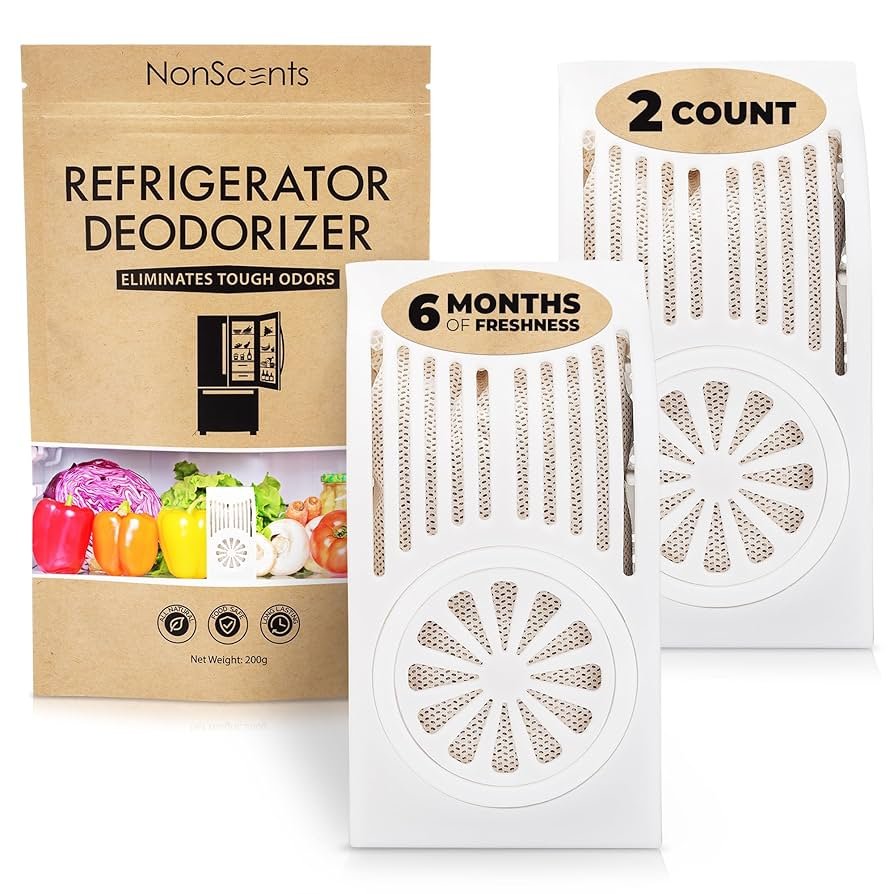
If you’re looking for a powerful, natural, set-and-forget solution, activated charcoal is your new best friend. And the NonScents brand has perfected it for fridge use.
- How It Works (The Science): This isn’t your BBQ charcoal. Activated charcoal is carbon that has been “activated” with heat and steam to create an incredibly porous internal structure. A single gram can have the surface area of a football field! This vast network of pores traps VOCs through a process called adsorption, where odor molecules are physically bound to the charcoal’s surface by weak intermolecular forces known as van der Waals forces. It doesn’t mask smells; it physically imprisons them.
- Installation and Optimal Placement: Simply remove the pouch from its plastic wrap. For best results, place it on a middle shelf toward the back of the fridge where air circulation is good. Avoid tucking it into a crowded door compartment.
- Longevity and Maintenance: One NonScents packet is rated to last up to six months. There’s no real maintenance, but some users of similar charcoal products “recharge” them by placing them in direct sunlight for a few hours every month or two, which can help release some trapped moisture and free up pore space.
- Why We Love It: It’s insanely effective, incredibly long-lasting, 100% fragrance-free, and completely natural. It’s the ultimate “set it and forget it” workhorse.
- Best For: Anyone who wants a potent, long-lasting, and completely natural solution to fridge odor.
2. The High-Tech Gadget: FRIDGE O3 Electronic Ozone Deodorizer
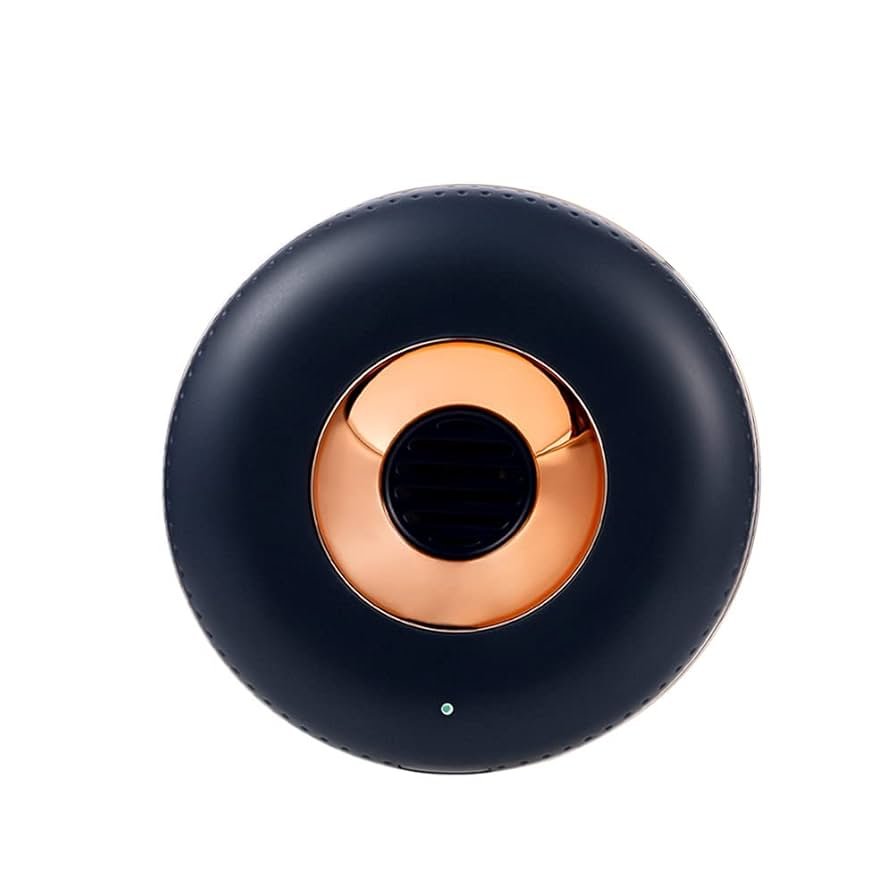
For the MindGearMen reader who loves a tech solution for every problem, this is it. The FRIDGE O3 isn’t just a passive absorber; it’s an active, smart device that sanitizes the air in your refrigerator.
- How It Works (The Science): This USB-rechargeable device uses corona discharge to create a controlled, safe amount of Ozone (O3). Ozone is an unstable molecule with three oxygen atoms. It desperately wants to get back to the more stable O2 form. To do this, it donates its extra oxygen atom to nearby organic molecules—like bacteria, mold spores, and smelly VOCs. This process, called oxidation, destroys the odor-causing compounds at a molecular level. It also neutralizes ethylene gas, a hormone that causes produce to ripen and spoil faster.
- Installation and Optimal Placement: Charge it fully via USB before first use. Place it high up in your fridge, as ozone is slightly heavier than air and will gently circulate downwards. Ensure it’s not blocked by containers.
- Longevity and Maintenance: A full charge typically lasts 30-40 days. Most models have an indicator light that blinks when it’s time to recharge. There are no filters or refills to worry about.
- Why We Love It: It’s an active purification system that not only kills odors but can genuinely extend the life of your produce, saving you money on groceries. The reusable, eco-friendly design is a huge plus for anyone looking to reduce waste.
- Best For: The tech-savvy homeowner, anyone serious about reducing food waste, and those who want the most powerful, active solution available.
3. The Heavy-Duty Hero: Fresh Wave Odor Removing Gel
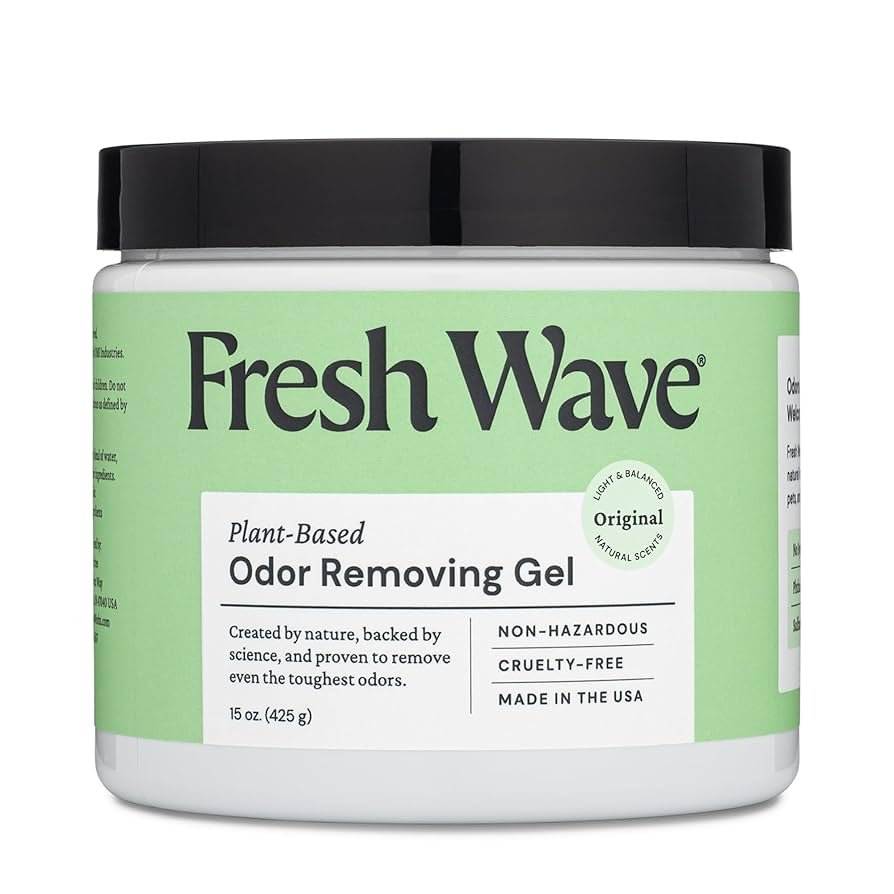
Sometimes you’re at war with a specific, powerful stench. Maybe it’s leftover salmon, a chunk of blue cheese, or a batch of kimchi. For these heavy-duty jobs, you need the targeted power of Fresh Wave Gel.
- How It Works (The Science): Fresh Wave uses a proprietary blend of natural plant oils (like pine, cedarwood, and lime) suspended in a water-based gel. As the gel evaporates, it releases these active plant molecules into the air. Unlike perfumes that just mask odors, these molecules are shaped to attract and bond with odor molecules like a lock and key, neutralizing them on contact and rendering them inert.
- Installation and Optimal Placement: Peel back the foil seal, replace the vented lid, and place it anywhere in your fridge. A door shelf is a great spot, as the movement from opening and closing the door helps circulate the air over the gel.
- Longevity and Maintenance: The gel will visibly shrink as it evaporates, providing a clear indicator of when it’s time to replace it, typically every 30-60 days. There’s no maintenance required.
- Why We Love It: It excels at eliminating stubborn, specific smells that other deodorizers struggle with. The natural ingredients are non-toxic, and it leaves a very subtle, clean scent that smells like a walk in the woods, not a chemical factory.
- Best For: Households that frequently cook with strong-smelling ingredients and need a reliable way to neutralize intense odors quickly.
4. The Budget Workhorse: Arm & Hammer Fridge-N-Freezer Odor Absorber
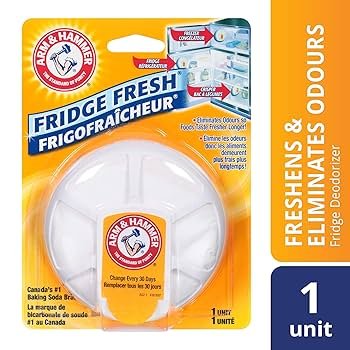
This is the classic, evolved. Arm & Hammer took their trusted baking soda and put it in a smarter package designed for maximum performance.
- How It Works (The Science): It’s still sodium bicarbonate, which is amphoteric, meaning it can neutralize both acidic and basic odors. The key innovation is the packaging. The box features highly porous paper panels on both the front and back, exposing a massive amount of the baking soda to the air. This design dramatically improves airflow and the rate of odor absorption compared to a standard, torn-open box.
- Installation and Optimal Placement: Simply pull off the front and back tear strips to expose the vents. Place it in your fridge or freezer. For best results in a crowded fridge, try to leave some space around it.
- Longevity and Maintenance: It is designed to be replaced every 30 days. Use a marker to write the replacement date on the box so you don’t forget.
- Why We Love It: It’s incredibly affordable and available everywhere. The spill-proof design is a simple but brilliant feature. For handling everyday, mild-to-moderate fridge odors, it’s a reliable and cost-effective solution.
- Best For: Anyone on a tight budget, people with mild odor issues, and as a baseline for general fridge and freezer maintenance.
5. The Everlasting Solution: Rub-A-Way Stainless Steel “Soap”
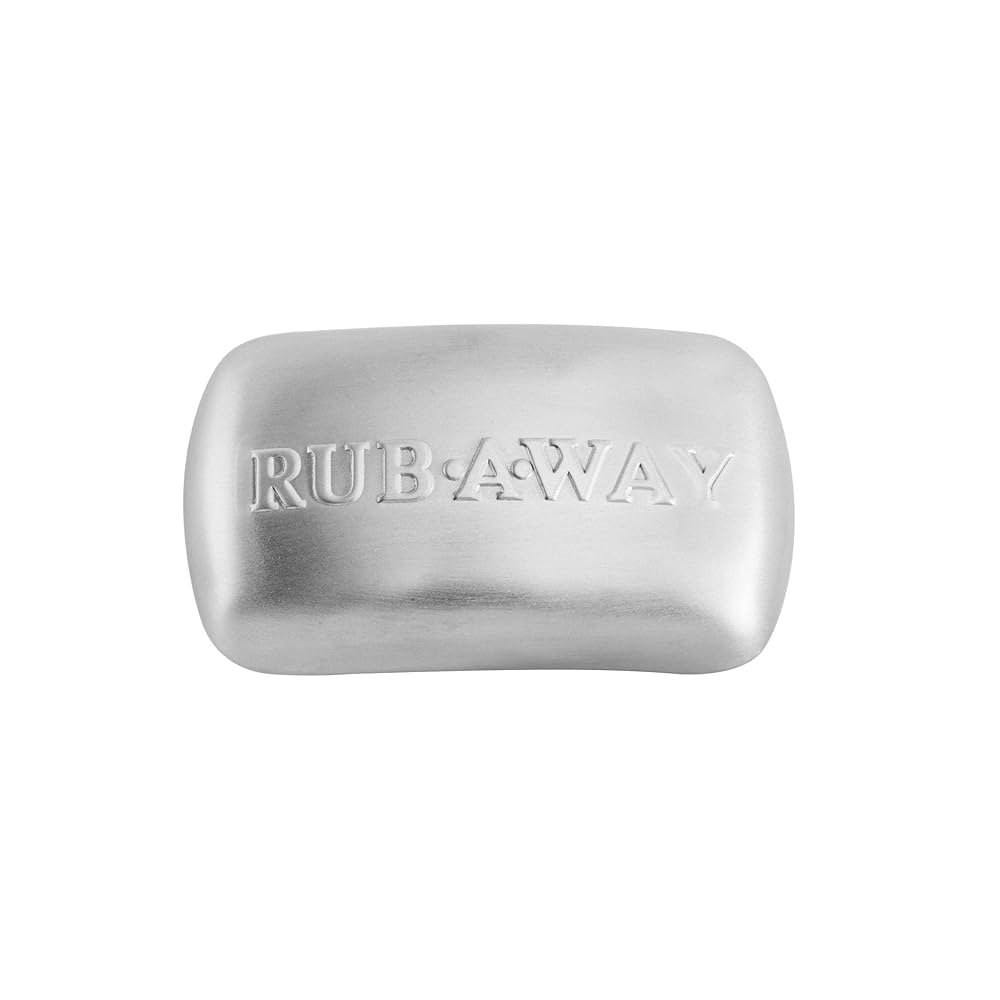
This one might seem like voodoo, but it’s pure chemistry. A simple piece of stainless steel can be one of the most effective tools against specific, stubborn smells.
- How It Works (The Science): The magic is in the chromium that’s part of the stainless steel alloy. This element binds tightly with sulfur compounds (like the allyl methyl sulfide in garlic and onions). This catalytic process neutralizes the sulfur molecules responsible for the most pungent and lingering food odors. Placing it in a small dish of water creates a hydro-catalytic reaction, enhancing its effectiveness in the air.
- Installation and Optimal Placement: Place the stainless steel bar in a small, shallow dish. Add a tablespoon or two of water and set it on a shelf in your fridge.
- Longevity and Maintenance: It lasts forever. Simply rinse it off every week or two to wash away any bound molecules and keep its surface reactive. That’s it. This is a one-time purchase.
- Why We Love It: It never runs out, never needs refills, and never expires. It’s the ultimate “buy it for life” piece of kitchen gear and is completely chemical-free.
- Best For: People who cook with a lot of onions, garlic, and fish, and want a permanent, chemical-free tool to fight those specific odors.
Beyond the Deodorizer: A 4-Step System for a Permanently Fresh Fridge
A great deodorizer is a fantastic tool, but the best defense is a good offense. Integrate these habits to prevent odors from ever taking hold.
- The Weekly Audit (FIFO): Practice “First In, First Out.” Once a week, before you go grocery shopping, pull everything out from the back of the shelves. Use up older items first and throw away anything that’s past its prime.
- The Right Storage Gear: Ditch the flimsy takeout containers. Invest in a set of airtight glass containers. They don’t absorb odors like plastic, and they let you see exactly what’s inside.
- The Wipe-Down Ritual: Clean up spills immediately. Don’t let them sit and become a food source for smelly bacteria. Keep a spray bottle of 50/50 water and white vinegar for quick, natural, and effective wipe-downs.
- The Temperature Check: Ensure your fridge is set to 40°F (4°C) or below. Any warmer and you’re entering the “danger zone” where bacteria can multiply rapidly.
Frequently Asked Questions (FAQ) About Refrigerator Deodorizers
Here are answers to some of the most common questions we get about choosing and using refrigerator deodorizers to achieve a perfectly fresh fridge.
Q1: Where is the absolute best place to put a refrigerator deodorizer? For most passive deodorizers like activated charcoal and baking soda, the best spot is on a middle shelf towards the back. Air circulates from back to front in most refrigerators, so this placement allows the deodorizer to treat the air before it flows over your food. For active devices like ozone generators, a higher shelf is ideal as the purified air will naturally circulate downwards.
Q2: My fridge still smells even after putting in a new deodorizer. What now? This is a common issue and it almost always means the source of the odor has not been removed. A deodorizer is designed to maintain a clean environment, not perform a miracle on an existing mess. You need to do a “deep search” for the culprit:
- Check for hidden spills under the crisper drawers.
- Wipe down the interior walls and shelves with a 50/50 vinegar and water solution.
- Look for forgotten leftovers or spoiling produce hidden in the back.
- Check your refrigerator’s drip pan underneath, as it can harbor smelly, stagnant water. Once you’ve eliminated the source, the deodorizer can effectively prevent new odors from taking hold.
Q3: Can I use all of these deodorizers in the freezer, too? Most of them, yes!
- Baking Soda & Activated Charcoal: Both are excellent for freezers, which can develop stale smells over time.
- Ozone Generators: These work very well in freezers to prevent freezer burn odor and ice crystal smells.
- Stainless Steel: Also effective in freezers.
- Gel Deodorizers: These are generally not recommended for freezers, as the gel can freeze solid, stopping the evaporation process that makes it work.
Q4: How do I really know when my charcoal or baking soda deodorizer is “full”? Unfortunately, there’s no visual “full” indicator.
- For baking soda, you must be strict about the 30-day replacement schedule. After a month, it has absorbed all it can and is no longer effective.
- For activated charcoal, the best practice is to follow the manufacturer’s recommended timeline (e.g., 6 months). The clearest sign it’s time for a replacement is the slow return of faint odors to your fridge.
Q5: What about DIY solutions like coffee grounds or a cotton ball with vanilla extract? While these might seem like clever hacks, they are masking agents, not true deodorizers. They work by covering up the bad smell with a stronger, more pleasant one. This doesn’t eliminate the odor-causing particles and can lead to strange scent combinations (like onion-vanilla-milk). The products on our list are designed to trap or neutralize odors, not just cover them up.
Q6: Do I need two deodorizers for my large side-by-side or French-door refrigerator? It’s a great idea, especially for side-by-side models. A good strategy is to place one deodorizer in the refrigerator compartment and another in the freezer compartment, as they have separate airflows and distinct odor challenges. For a large, open French-door fridge, one powerful unit like an ozone generator or a large charcoal bag may be sufficient, but placing two smaller units on different shelves can also improve effectiveness.
Q7: Are the natural oils in gel-based deodorizers safe for people with scent sensitivities? This is an important consideration. While the ingredients are natural, anyone with a known sensitivity or allergy to essential oils (like pine, cedar, or citrus) might find the subtle scent irritating. If you or a family member is highly sensitive to fragrances of any kind, your safest options are the completely odor-free deodorizers: activated charcoal, baking soda, or stainless steel.
A Breath of Fresh Air is an Easy Upgrade
Your refrigerator is one of the hardest-working appliances in your home. Giving it the right gear to stay clean and fresh isn’t a luxury—it’s a simple upgrade that improves your daily routine.
Putting an end to unpleasant fridge odors is easier and more effective than ever. You now have the knowledge to choose the perfect tool for the job. Whether you opt for the natural trapping power of activated charcoal, the high-tech sanitation of an ozone generator, or the budget-friendly reliability of engineered baking soda, you’re taking a simple step toward a cleaner, more pleasant kitchen. A fresh-smelling fridge means better-tasting food and a more enjoyable experience every time you open the door.
What are your secrets to fighting fridge funk? Do you have a favorite deodorizer we missed? Share your tips and experiences in the comments below—we’d love to hear them! Also don’t forget to subscribe to mindgearmen.com.


